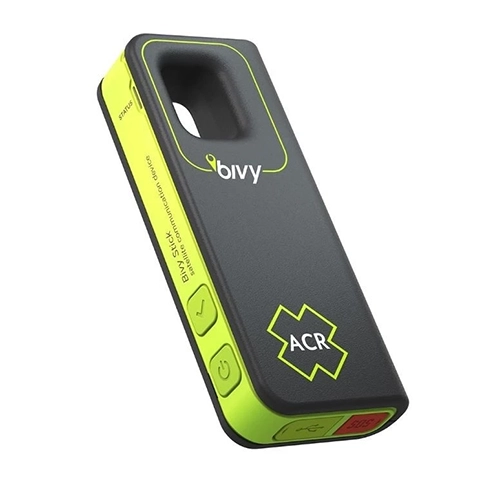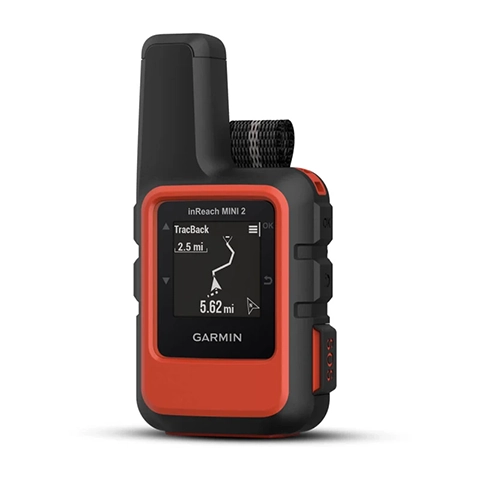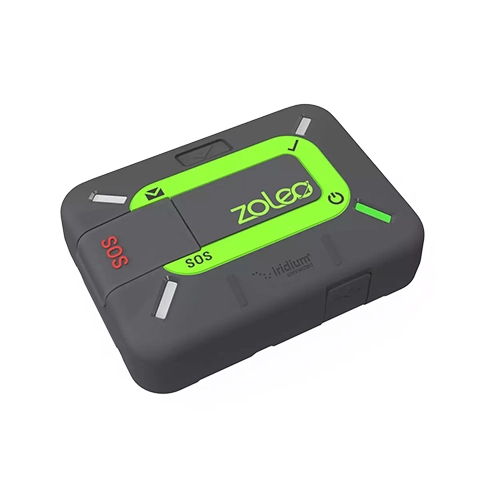

Heading into remote areas means going far from cell phone reception. While this can be peaceful, it also comes with risks if something goes wrong.
Getting lost, injured, or in danger miles from help can quickly become an emergency. This is why a satellite messenger should be essential gear for every backpacker.
But with different satellite messengers available, how do you pick one while keeping your pack light? Our guide looks at top lightweight options to help you choose the best device for your trips.
Let’s get started.

Key Specs
Weight: 3.53 ounces (100 grams)
Two-way Messaging Feature: Via phone app
Battery Life: 120 hours
Subscription Required: Yes
Price: $$
PROS
✅ Ultralight
✅ Solid Hardware
CONS
❌ Troublesome app
❌ Learning curve
The ACR Bivy Stick offers global satellite communication for outdoor adventures, serving as a reliable hardware device to keep you connected off the grid.
However, it heavily relies on the Bivy Stick app, which has some drawbacks. Both the Android and iPhone apps can drain phone batteries quickly and may freeze in areas with no cell service. To mitigate this, only allow the app to use GPS when necessary. Additionally, it requires a clear view of the open sky for the best signal strength.
On the positive side, it offers two-way messaging, emergency SOS, group tracking, and offline maps. During our testing, we found that some initial messages ended up in the recipient’s spam folder, but this can be easily resolved on your computer.
If your primary purpose is to have a device for emergencies and simple check-ins, the ACR Bivy Stick is a decent ultralight choice. However, it’s important to rely on the device for check-ins rather than the app, as the app’s location accuracy can be inconsistent. In conclusion, practice using the device to make the most of it.

Key Specs
Weight: 3.53 ounces (100 grams)
Two-way Messaging Feature: Yes (No phone required)
Battery Life: 336 hours
Subscription Required: Yes
Price: $$$
PROS
✅ Basic navigation
✅ Great battery life
✅ No need for a phone to send messages
CONS
❌ Expensive
The Garmin inReach Mini 2 is an impressive satellite messenger backed by strong hardware capabilities. Its compact and light design makes it very packable for outdoor adventures.
Key strengths include global two-way messaging and location tracking that provide reassurance for solo trips off the grid. Direct navigation to waypoints and points along multi-stage routes enhances trip planning flexibility.
However, some downsides exist. Setup requires downloading Garmin software which adds complexity versus plug-and-play use. Initial contact selection is also not easily changed once registered.
Battery life under heavy use may fall short of estimates, so having backup power is wise. Additionally, expensive monthly plans contain some hidden costs over time.
Message delivery and activation can experience minor delays at times as well. But the inReach Mini 2 more than makes up for it with robust internals and the ability to operate independently of a phone.
While not perfect, its blend of functionality, convenience and self-sufficiency continue to make it the top choice overall. Garmin also actively improves support, and new models will likely address some issues. For most outdoor communicators, the Mini 2 provides strong piece of mind in any remote pursuit.

Key Specs
Weight: 5.29 ounces (150 grams)
Two-way Messaging Feature: Via phone app
Battery Life: 200 hours
Subscription Required: Yes
Price: $$
PROS
✅ Solid hardware
✅ Great battery life
CONS
❌ Troublesome app
The ZOLEO Satellite Communicator offers a mix of advantages and considerations for outdoor enthusiasts. It’s a cost-effective choice with dependable performance and a long-lasting battery, making it valuable, especially in remote places. The option to pause service during the offseason is a handy feature, and automatic location sharing enhances safety.
However, there are some challenges to be aware of, like issues with the app’s user-friendliness and setup process, which may require tech support assistance, a common scenario with such devices. Placing the device in an open area is vital for optimal performance, and device availability can sometimes be an issue, so buying from a ZOLEO reseller is recommended.
Despite these challenges, the ZOLEO Communicator serves as a useful tool for solo adventurers who need a reliable way to stay connected in areas lacking cell coverage.

Key Specs
Weight: 5.08 ounces (144 grams)
Two-way Messaging Feature: No (SOS only)
Battery Life: 24 hours (5-year shelf life)
Subscription Required: No
Price: $$$
PROS
✅ No subscription required
✅ Solid hardware
CONS
❌ Accidental activation is a possibility
❌ Not the best GPS signal lock
While primarily designed as a personal locator beacon rather than a satellite messenger, meaning it can only transmit an SOS signal and cannot send or receive other messages, the ACR ResQLink 400 can be an important safety tool for outdoor enthusiasts when used properly.
It utilizes multiple signal technologies including GPS, 406 MHz, and 121.5 MHz to communicate your location to worldwide search and rescue networks, ensuring help can be located in an emergency. This diverse signaling gives peace of mind in knowing assistance can be dispatched.
The registration process is straightforward, and the instructions are easy to follow, making it user-friendly. Its compact and lightweight design is convenient for hikers, and the self-test function with 12 tests provides peace of mind.
Some users have reported that holding the unit in hand can potentially interfere with signal transmission, so it’s advisable to place it on the ground in an emergency. This is an area that could be improved with better shielding or mounting accessories to maintain optimal performance.
While there is room for improvement, such as offering more mounting and carrying options and better GPS signal protection, our overall assessment is positive. The ACR PLB is durable and waterproof, making it a valuable investment as it gives peace of mind without requiring a subscription.

Key Specs
Weight: 5 ounces (142 grams)
Two-way Messaging Feature: No (pre-programmed one-way messages only)
Battery Life: 168 hours
Subscription Required: Yes
Price: $
PROS
✅ Great battery life
✅ Extremely affordable
CONS
❌ Not for heavily wooded areas
❌ No bluetooth support
The Spot Gen4 is a simple and cost-effective GPS communication device. It’s a budget-friendly option with clear and transparent pricing, so you won’t face hidden fees.
This device keeps you connected with loved ones or emergency responders through custom messages (up to 1,250) and an SOS button. It can also be set to regularly share your location on a map so that your friends and family can see where you are from their homes.
However, one limitation is its lack of Bluetooth support, meaning you can’t connect it to your phone, which sets it apart from some other devices in this category.
To ensure successful message transmission, it’s essential to carefully read the manual and follow the instructions. Keep in mind that the Spot Gen4 might not be the best choice for hikers in heavily wooded areas. Nevertheless, given its affordable price point, it’s worth considering.
The Spot Gen4 is a useful tool to stay connected, even though it might have some difficulties at times. It’s important to remember that this device only allows one-way communication, so you won’t know if help is coming your way.
If you’re interested in Spot devices, you can also explore the Spot X, which offers a better user interface and Bluetooth support.
When venturing off the grid, a satellite communicator can provide an invaluable link in an emergency. It’s important to evaluate your needs and priorities.
Personal locator beacons (PLBs) function solely as emergency devices, allowing extended battery life for multiple trips via automated SOS signaling. However, their communication is limited to distress alerts.
For more versatile use, consider one- or two-way satellite messenger:
Managing two connected devices is required for phone-linked versions. Consider needs versus convenience.
Other factors to compare include:
Products like the Garmin inReach balance functionality and simplicity.
Evaluate usage scenarios like frequency, locations, activities and group sizes. Research thoroughly based on priority features to select the optimal safety companion for any outdoor adventure.
To learn more about how these devices, explore our in-depth post here.
A satellite messenger is an essential piece of gear for backcountry adventures like backpacking, mountaineering, and wilderness expeditions where you venture beyond cell phone reception. Satellite messengers allow you to communicate from remote locations by sending SOS alerts and text messages via satellite networks. Unlike cell phones that rely on towers, satellite messengers work virtually anywhere through communication with orbiting satellites. This allows you to call for help from anywhere in an emergency and provides peace of mind when you are far off the grid. Satellite messengers are compact, durable devices that can be a lifesaver for backcountry travelers exploring mountainous terrain or deep wilderness areas.
While satellite messengers are primarily emergency communication devices, some models do provide basic navigational capabilities. Many messengers allow you to share your GPS coordinates so contacts can view your location. Some models have navigation features like locating coordinates, checking compass headings, tracking routes, and mapping waypoints. However, satellite messengers have limited screens and maps compared to dedicated GPS devices. For full backcountry navigation capabilities with topographic maps, route planning tools and more advanced features, you will likely want to pair your messenger with a standalone GPS unit or navigation app.
Satellite messenger prices range from $150 to $500 for the device alone, depending on the features. Most messengers also require an annual or monthly subscription, costing between $12 and $45 per month for messaging. Budget-friendly options like inReach and Somewear offer basic two-way messaging and SOS with lower subscription fees. Mid-range models have added navigational features and improved displays, with moderate subscription costs. Top-tier messengers boast extensive coverage, rugged builds, extra power options, and advanced navigation tools but come with higher subscription fees. While budget options work, investing in a more full-featured model can offer better reliability and capabilities for high-risk wilderness adventures. Your needs and budget will determine the right balance of affordability and functionality in a satellite device and subscription.